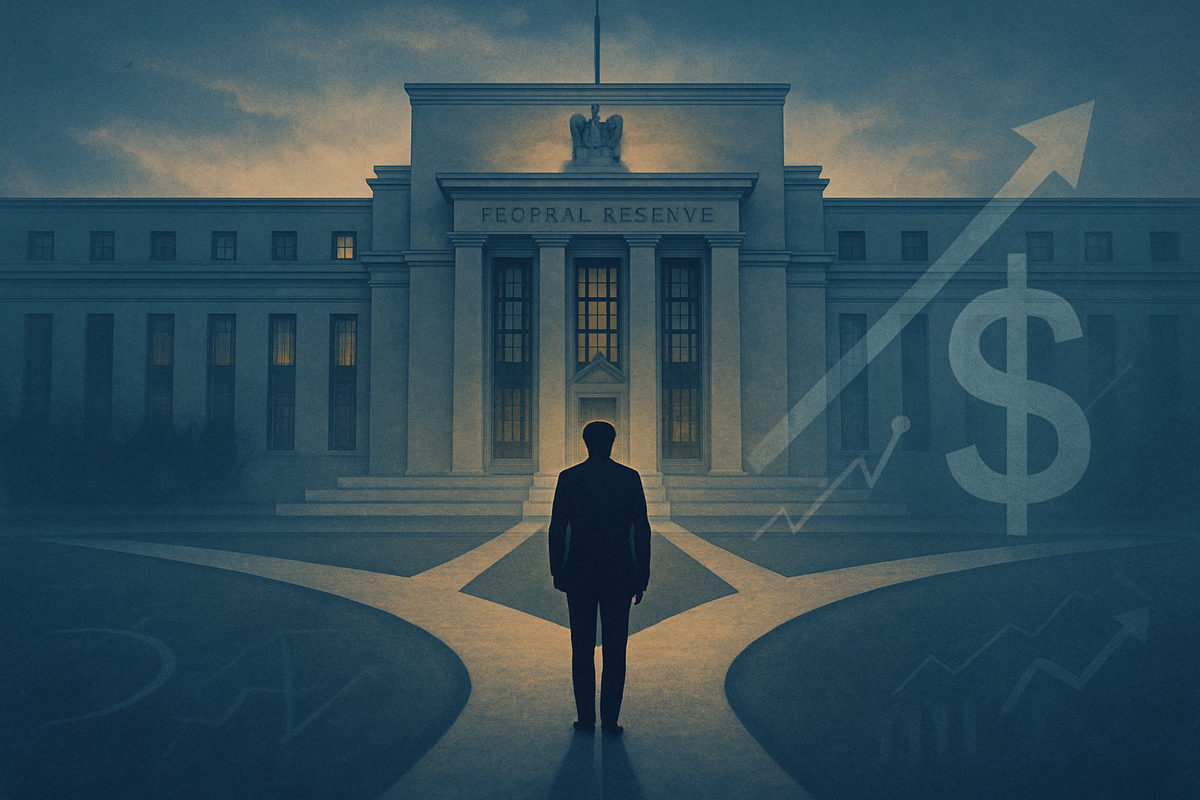
As of November 3, 2025, Federal Reserve Chair Jerome Powell's second term is nearing its conclusion in May 2026, setting the stage for a pivotal leadership transition that could dramatically reshape U.S. monetary policy and the trajectory of interest rates. With President Donald Trump actively seeking a successor, the central bank finds itself at a critical juncture, facing intense political pressure and the potential for a significant shift away from Powell's measured approach. This impending change introduces a layer of uncertainty into financial markets, as investors and businesses brace for the implications of new leadership on inflation, employment, and economic stability.
The stakes are exceptionally high, particularly as the Fed navigates a complex economic landscape characterized by persistent inflation above its 2% target and a weakening labor market. The appointment of a new Chair, especially one aligned with a more dovish stance, could usher in an era of more aggressive rate cuts, potentially stimulating the economy but also risking further inflationary pressures. The debate surrounding the Federal Reserve's independence from political influence is also at the forefront, with market participants keenly observing whether the institution can maintain its autonomy amidst external pressures.
Powell's Tenure and the Search for a Successor
Jerome Powell, who first took the helm in February 2018 and was reappointed for a second term in May 2022, has guided the Fed through unprecedented challenges, including the recent resurgence of inflation. His leadership, as of November 3, 2025, has seen the implementation of two quarter-point interest rate cuts in September and October, bringing the benchmark federal funds rate to a range of 3.75% to 4%. These adjustments were made in response to signs of a softening labor market, even as the battle against inflation continues. Powell has, however, signaled caution regarding further cuts, acknowledging "strongly differing views" within the Federal Open Market Committee (FOMC). Concurrently, the Fed announced the cessation of its quantitative tightening program, with the reduction of its securities holdings expected to conclude by December 1, 2025.
The timeline for this leadership transition is critical. While Powell's term as Chair ends in May 2026, he is slated to remain on the Board of Governors until February 2028. However, with a hypothetical President Trump in office, the search for a new Chair is well underway. President Trump has publicly stated his intention not to reappoint Powell, citing dissatisfaction with his performance. This active presidential search underscores a desire for a Fed Chair whose monetary policy aligns more closely with the administration's economic objectives, particularly a preference for lower interest rates.
Key players in this unfolding drama include current Chair Jay Powell, whose legacy is now being evaluated, and President Donald Trump, who will ultimately nominate the next leader. Several individuals are reportedly under consideration for the top post, including former Fed Governor Kevin Warsh, former White House economic advisor Kevin Hassett, current Fed Governor Christopher Waller, and current Treasury Secretary Scott Bessent. Any nominee would require confirmation by a Republican-controlled Senate, highlighting the political dimension of this crucial appointment. Initial market reactions have been characterized by a cautious watch-and-wait approach, with investors weighing the potential for a more accommodative monetary policy against concerns about the erosion of the Fed's cherished independence, which could lead to "considerable financial market and economic turbulence."
Corporate Winners and Losers from a Policy Shift
The direction of Federal Reserve leadership and its subsequent monetary policy will create distinct winners and losers across various sectors of the public market. A shift towards a more dovish stance, prioritizing growth through lower interest rates, would significantly benefit capital-intensive industries such as construction, manufacturing, and utilities, as borrowing costs for large projects would decrease. Companies like Caterpillar (NYSE: CAT) could see increased demand for equipment. Technology and growth stocks, which often rely on debt for innovation and expansion, would also thrive as lower interest rates reduce their borrowing costs and enhance the present value of future earnings. Fintech companies like Block (NYSE: SQ) might see improved margins and reduced default risks. The real estate sector and homebuilders, along with consumer discretionary companies, would also gain from increased affordability and consumer spending. Smaller companies, often more sensitive to rate changes due to higher proportions of floating-rate debt, would also tend to outperform.
Conversely, a dovish pivot could pose challenges for savers and fixed-income investors, who would see reduced returns on deposits and bonds. While lower rates can stimulate lending, prolonged low rates might compress net interest margins for financial institutions like JPMorgan Chase (NYSE: JPM) and Bank of America (NYSE: BAC), impacting their profitability.
Should the Fed maintain or shift towards a more hawkish stance, prioritizing inflation control through higher interest rates, the landscape would reverse. The financial sector, including major banks and insurance companies, generally thrives in a rising interest rate environment as net interest margins expand. Companies with large cash reserves, such as Apple (NASDAQ: AAPL) or Intel (NASDAQ: INTC), would see increased interest income. Defensive sectors like consumer staples (e.g., Procter & Gamble (NYSE: PG), Walmart (NYSE: WMT)) and healthcare would also be more resilient due to stable demand for their essential goods and services.
However, a hawkish policy would significantly hurt capital-intensive industries, technology and growth stocks, and the real estate sector due to higher borrowing costs. Companies with high debt loads, like Thryv (NASDAQ: THRY), would face increased interest expenses, squeezing profits and free cash flow. Consumer discretionary spending would likely decline as consumers face higher borrowing costs for loans and credit. The current mixed signals from the Fed, with recent cuts but cautious forward guidance, underscore the market's delicate balance and the significant implications for corporate performance depending on the eventual policy direction.
Wider Significance: Independence Under Scrutiny
The potential Federal Reserve leadership transition transcends a mere personnel change; it represents a critical inflection point for the U.S. and global economies, particularly regarding the central bank's cherished independence. This event unfolds amidst several broader industry trends. The monetary policy shift, with recent rate cuts to 3.75%-4.00% and the cessation of quantitative tightening by December 2025, reflects the Fed's current battle against slowing growth and persistent inflation. A new Chair would inherit this delicate balance, potentially altering the emphasis on either combating inflation or stimulating economic growth, which has profound implications for interest rates and market expectations.
The ripple effects of a leadership change are substantial. Policy uncertainty typically leads to increased market volatility, forcing investors to adjust strategies. Financial institutions will closely monitor shifts in interest rate policy, regulatory oversight, and liquidity management, which directly impact their profitability and risk management. Crucially, global market confidence and the strength of the U.S. dollar hinge on the perception of the Fed's independence. Any perceived political interference in the appointment process or policy decisions could undermine this independence, potentially leading to a weaker U.S. dollar, higher bond yields, increased risk premiums for U.S. assets, and a shift of capital away from U.S. Treasuries. Such a scenario could also complicate international monetary policy coordination, given the U.S. economy's global influence.
The regulatory and policy implications regarding Fed independence are paramount. The Federal Reserve was deliberately structured with safeguards—such as 14-year terms for governors and staggered appointments—to insulate it from short-term political pressures. However, President Trump's public criticism of Chair Powell and stated desire to appoint a successor aligned with his economic agenda highlight a significant test of these safeguards. If the new leadership is perceived as overtly political or less committed to the Fed's dual mandate, it could erode the institution's credibility and increase policy uncertainty. Historical precedents, such as the Treasury-Federal Reserve Accord of 1951, underscore the importance of Fed independence in effectively managing monetary policy and maintaining economic stability. The eras of past Chairs like Paul Volcker, Alan Greenspan, and Ben Bernanke demonstrate how a new leader can significantly alter the Fed's approach to its mandates, often coinciding with major economic shifts.
What Comes Next: Navigating Uncertainty
The period leading up to and following a potential Federal Reserve leadership change in May 2026 promises a dynamic and uncertain economic landscape. In the short term, from late 2025 through 2026, policy uncertainty and market volatility are likely to persist. With the economy experiencing decelerating growth, reaccelerating inflation, and a cooling labor market, the Fed's path will remain highly data-dependent. Chair Powell's recent "hawkish cut" in October 2025, bringing the federal funds rate to 3.75%-4.00%, signals a cautious approach, balancing inflation concerns with employment risks. Further rate adjustments will be scrutinized, especially given the "strongly differing views" within the FOMC, which could lead to unpredictable decisions or a more gradual pace of easing than markets anticipate. The ongoing political pressure from President Trump for lower interest rates will further complicate the Fed's immediate decision-making.
Looking further ahead, beyond 2026, the long-term trajectory of monetary policy will be shaped by the new Chair's philosophical approach and the outcomes of the Fed's 2025 monetary policy framework review. This review is assessing the effectiveness of its "Statement on Longer-Run Goals and Monetary Policy Strategy" and may lead to the adoption of new strategies, such as price-level targeting or average-inflation targeting, to address persistent inflation shortfalls. A new leader might also need to address structural vulnerabilities within the Fed's "ample reserves" system and navigate the complex interplay between fiscal policy and rising national debt, which poses significant long-term risks to the Fed's independence and its ability to achieve its mandates.
Potential strategic pivots will be crucial. A new Chair might re-evaluate the balance between the Fed's dual mandate of maximum employment and price stability, adapting to prevailing economic conditions. Enhanced communication will be paramount to manage market expectations and maintain credibility during this transition. Investors will face both challenges and opportunities. Challenges include heightened policy uncertainty, potential market overreactions, and the risk of a weakened U.S. dollar if a significantly dovish stance is adopted, or higher borrowing costs if Fed independence is perceived to be compromised. Opportunities may arise from a re-evaluation of asset classes, with shifts towards commodities or inflation-protected securities if inflation expectations rise, or sector-specific performance shifts favoring growth stocks in a prolonged low-rate environment or defensive sectors if rates remain higher.
Several scenarios could unfold following a new appointment. A "hawkish" Chair, prioritizing inflation control, could lead to a stronger U.S. dollar and higher bond yields, potentially challenging equity markets. Conversely, a "dovish" Chair, emphasizing growth and employment, might trigger an equity market rally and a weaker dollar, with rising inflation expectations. The most precarious scenario involves a "politically influenced" appointment, which could undermine the Fed's credibility, leading to increased market volatility, higher long-term borrowing costs, and a significant weakening of the U.S. dollar as a global reserve currency. The extent to which the Fed maintains its independence will be the defining factor in determining the long-term stability and effectiveness of U.S. monetary policy.
Comprehensive Wrap-up: A Defining Moment for the Fed
The impending conclusion of Jay Powell's second term as Federal Reserve Chair in May 2026 marks a profound crossroads for the institution and the broader financial markets. The transition comes at a delicate economic moment, characterized by slowing growth, reaccelerating inflation, and a cooling labor market, with the Fed having recently executed two cautious rate cuts to a range of 3.75%-4.00%. The overarching takeaway is the significant uncertainty surrounding future monetary policy, heavily influenced by the political process of appointing Powell's successor and the new Chair's philosophical approach to the Fed's dual mandate. This leadership change is not merely a personnel shift but a potential redefinition of the central bank's strategic direction and its commitment to independence.
Moving forward, the market will be keenly assessing the signals from Washington and the Federal Reserve. Investors should watch closely for President Trump's nominee, the Senate confirmation process, and any early indications of the new Chair's policy inclinations – whether a more aggressive dovish stance to spur growth or a continued hawkish vigilance against inflation. The composition of the FOMC and the internal debates surrounding interest rate policy will also be critical. The market's assessment of Fed independence will be a crucial determinant of confidence, with any perceived political interference potentially leading to significant financial market turbulence and a weakening of the U.S. dollar.
The lasting impact of this transition could be profound. A truly independent Federal Reserve, committed to its dual mandate, is a cornerstone of global financial stability. A shift towards a more politically influenced Fed could erode this trust, leading to long-term economic instability and increased volatility. Conversely, a strong, independent leader could reaffirm the Fed's role, guiding the economy through its current challenges while maintaining credibility. Investors should position their portfolios with an eye towards potential shifts in interest rate trajectories, currency movements, and sector-specific performance. Diversification and a focus on companies with robust balance sheets will be prudent strategies in the coming months, as the financial world awaits clarity on who will steer the powerful Federal Reserve through its next chapter.
This content is intended for informational purposes only and is not financial advice




